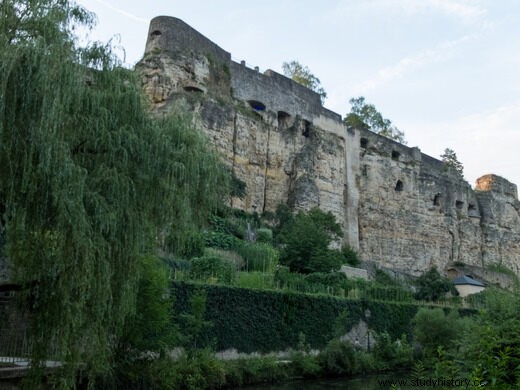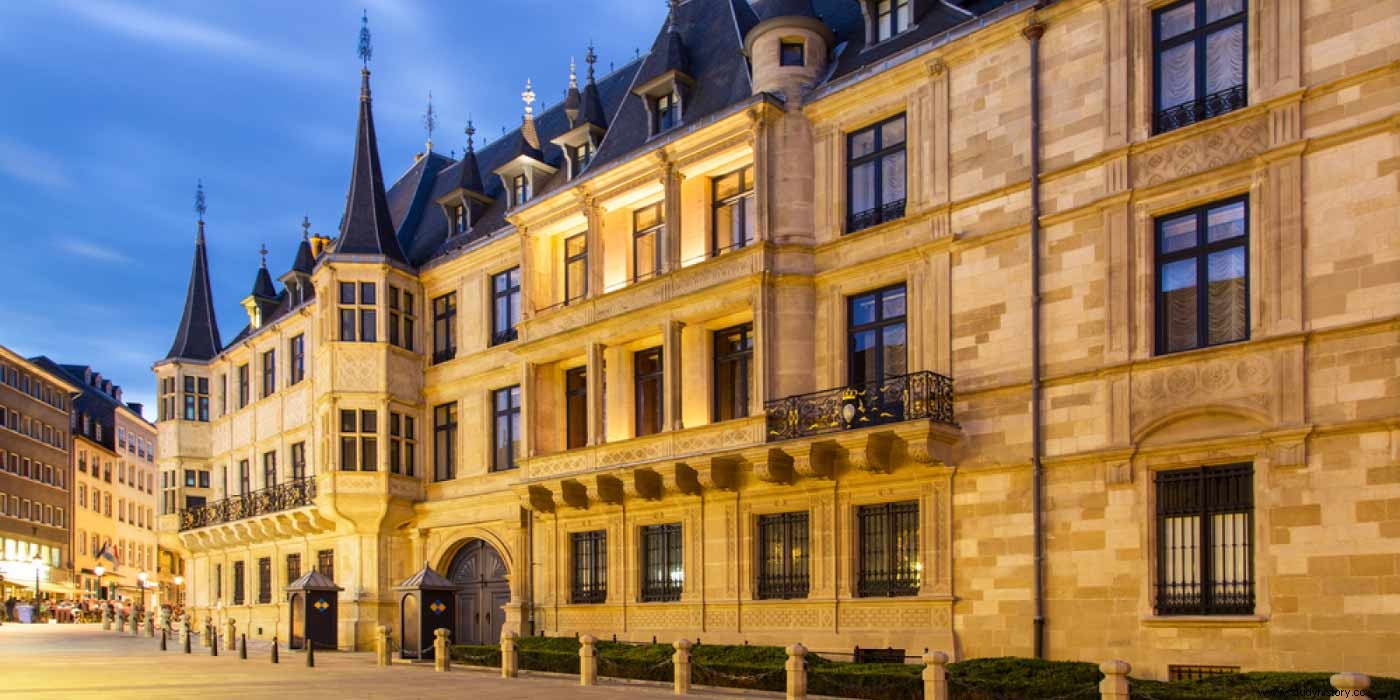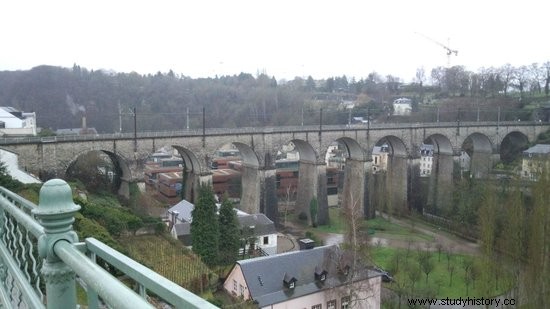A BRIEF OVERVIEW

The Grand Duchy of Luxembourg is a locked country in Western Europe, Luxembourg happens to be one of the richest countries in the world. Although it is very small in the area and the least populous country in Europe, the convenient location of Belgum, France and Germany makes it a wonderful place to visit. These countries are also major trading partners for Luxembourg. The rolling hills and forests are home to beautiful churches and castles. The European Union has four official capitals and Luxembourg is a capital city with three official languages:Luxembourgish, German and French. Foreigners themselves occupy much of the population of this country,
In 1994, UNESCO declared it a World Heritage Site due to its fortifications and homes. At present it is a sovereign Grand Duchy and headed by Grand Duke Henry. The inhabitants here have always lived a good lifestyle and high living standards. the country has always excelled in per capita income and economic development
SOME HISTORICAL BACKGROUND
- Luxembourg, initially appeared at 10 th century and even then it has been under the radar of many kingdoms and states, but it tried its best to remain an independent political entity.
- The place was fortified by Count Siegfried and his descendants, and they ruled until 13 th century. The "Fortress of Luxembourg" and the city became places of paramount importance due to its location between the Habsburg Territories and the French Empire. It is still considered one of the largest fortifications in world history.
- Under Napoleon, the province grew to become part of the First French Republic for quiet times until the early 19th century.
- But in 1815, after Napoleon was defeated, Luxembourg finally formed an alliance with the Netherlands and emerged as a recognized country at the Congress of Vienna the same year.
- Due to some hostilities during the Belgian Revolution of 1849; Belgium was renounced from the purely French-speaking part of Luxembourg and the current state of Luxembourg, which we now know was given to the Luxembourgish-speaking part.
- From the year 1867; Luxembourg became a single independent country, led by a constitutional monarch and a parliamentary democracy. The country's supreme law was passed on October 17, 1768
- Although the neutrality of the country has been questioned and attacked in time and tough during the world wars; it continued to take a stand and seized power.
CULTURE AND ETHNISITY IN LUXEMBOURG
Although the country has sometimes retained its popular traditions; it is little overpowered by its Europeon counterparts, but it has still been called Europe's Capital of Culture, twice. The events held here promote the exchange of ideas. Luxembourgh had always been an active participant in the Eurovision Song Contest. In fact, even in 2010, this country represented itself as the "Green Heart in Europe" at the Shanghai event. World-famous artists such as Theor Kerg, Joseph Kutter &Michael Majerus, photographer Edward Steichen are also originally from this country. We can not already deny the fact that the city itself is a UNESCO World Heritage Site.
The cuisine of this country has largely been influenced by the neighbors — Germany and France; Even the immigrant settlers-Portuguese and Italians are also quietly responsible when it comes to dishes. There is a huge sale of alcohol in this region.
There are certain mandatory languages that are officially recognized in the states, but otherwise it is a very secular state. Some officially recognized religions include Roman Catholicism, Judaism, Greek Orthodoxy, etc. Luxembourg welcomes people from all over the world. The inhabitants of Luxembourg are rightly called Luxembourgers. A recent study has shown that almost 50% of the population are foreigners and people are happy that the state lives with each other multilingual. A decade-old survey showed that the most widely spoken language was French, then Luxembourgish and then German and English. While French is considered an important business communication language here, Luxembourgish is very popular with the local masses.
EDUCATION AND HEALTH
The education here is quiet remarkable- It is a trilingual education system. The first years of primary school are in the mother tongue, it becomes Gemran after quiet sometimes, and for a large part of the school it is actually French. In addition, English is also taught. Although skills in the previous three are important or preferred until school is completed, in the meantime children also learn English.
The Luxembourg government spends a large amount of its GDP on public health. The country spends around 7% of its GDP on health, making it one of the highest spending countries. That's actually around $ 8,000 for each resident.
RESOURCES
Luxembourg does not seem to have as many natural resources as its neighbors, but the investment in human resources or labor is remarkable. Most energy needs are covered through imports. Nuclear power is hardly there, but hydropower seems to be the only source of indigenous power.
PRESENT CONDITION-
Luxembourg is currently the most prosperous country in Europe and is also in third place among the richest in the world. It has many good rankings from being a country with high living standards to being a place that is very suitable for business, Luxembourg has it all
Luxembourg is home to the European Court of Justice, several EU administrative offices and large investment banks. As a member of the UN and NATO, the country has very well integrated outsiders and its own citizens; by giving everyone the right to vote.
The Luxembourg passport is in fifth place in the world; residents receive visas on arrival or visa-free access to 187 countries and territories. The country has a goal of reaching zero emissions by 2050 and to increase its organic farming growth by five times from now on. Even in Safety and Security, Luxembourg has performed very well from a few years. Ranked 4th out of 132 countries, and has emerged as one of the world's best players in environmental protection, according to the 2012 Environmental Performance Index. In fact, even in the "World's Most Livable Cities", Luxembourg ranks sixth among the top ten.
Let's immerse ourselves in our tourist feelings and get to know what to explore in this country!
1. Bock Casements

This powerful fortress in Luxembourg was built in 963, once known as Gibraltor. The Bock was built by Count Siegfried, and is the name of both the rocky headland and the fortress. Although most were demolished in 19 th century, but the defensive area structures have been expanded with rules from time to time.
2. Beafort Castle

Located just outside the city of Beaufort, it is a masterpiece merging both the Renaissance and the Middle Ages. Although it was built on 11. th century, these castles have been enlarged, annexed and undergone many changes since, but it has also been a national monument in Luxembourg since 1988. Currently only 9 people per group can visit this castle, and it is open only during the Winter season.
3. Grand Ducal Palace

This Renaissance building is definitely a place you must visit for special organized tours for the public. Since it is the official residence of the country's monarch-it can be visited at its special times from July to September. Tourists can enjoy the elegant interior, the ceremonial rooms and knowing very deeply and historically about the place by local guides.
4.Larochette

Surrounded by forest and nestled in a rocky, narrow valley-is the old market town of "Larochette". In the valleys of White Ernz are partly built castles here. Industrial breath medieval square and a number of historical monuments are all tourist attractions. Even the neo-Roman church, views such as the castles of Nommerlayen and Meysembourg are a feast for the eyes.
5.Park Merveilleux

Located in Bettembourg, 3 km from the French border and 6 km from the capital, this entertainment center attracts thousands of visitors each year with its fantastic adventurous themed tours. There is also a zoo inside with exotic reptiles, birds and mammals. The park has pony express, restaurants, concrts etc. There is also an interesting zoo component which houses a large collection of exotic birds, reptiles and many cute and cuddly mammals.
6. NotreDam Cathedral

The Roman Catholic Notre-Dame Cathedral in Luxembourg City was built in the early 17th century and the late Gothic-style Rennaisance Architecture, and has three remarkable towers and two original chancel sites. The presence of monuments around, in memory of the world war movement is symbolic here.
7 Upper Sûre Nature Park and Esch-sur-Sûre

Located somewhere in an old cloth mill, this place is a fusion of valleys, plains and wooden hills and the beautiful central lake of this place. People like to spend time here too for their quiet activities. It is also known for its eco-tourism, wildlife and water sports. Hiking is also arranged here for trips around the lake. Diving, fishing, swimming and solar-powered trips are also few activities here.
The presence of the Museum also depicts the rich cultural heritage. a very famous event here is the Water Art Festival , which attracts around 200 musicians at a time.
Esch-sur-Sûre is a place nearby from here by the river and between the mountains; provides a spectacular view. The mansions here have free admission all year round.
8. the old quarter of Luxembourg City

This historic old quarter, often referred to as "the City", has been a UNESCO World Heritage Site since 1994.
This can be said as the first point of exploration in Luxembourg; to travel through beautiful gardens and small alleys. The city's landmark, The Adolphe Bridge, also happens to be here. There are charming buildings and homes along the streets. The park-and-ride facility here makes it very convenient for all travelers to get past.
9. National Museum of History and Art, Luxembourg by

Even judging the already amazing city by the number of major historical museums, it will still top the list. The National Museum of History and Art is located in the Old Town and is at the top of the list.
Tools, arms, coins, archeological finds, artefacts, furniture, etc. are all part of the museum here and contribute to the amazing beauty. The Gallo-Roman period and the contemporary art section is a must-see that has been beautifully depicted through illustrations.
10. Walls Of The Corniche

Known as "The most beautiful balcony in Europe", with beautiful river below and the presence of the large "Gate to Ground" since 1632-it depicts the old refugees and the wealthy houses and also St. Michael's Church. The large building in the suburbs and the old monastery Neumünster are still remarkable
11. Benedictine Monastery in Echternach

This place dates back to the 17th century and consists of a central courtyard and four buildings. It also has religious significance. It's a sarcophagus from St.Willibrord (made of colorful frescoes and white marble). The adjoining museum also makes it a sight to behold.
12. by Vianda

Near the shores of Rover Our, the city of Vianda is a majestically beautiful city, surrounded by a medieval outer wall and watchtower; it has a manor house built in the 9th century. It is also a famous cauldron because Victor Hugo had lived here during the period of exile. For a fantastic view of the landscape, there is a chairlift that can rise to 440 meters.
13. Filharomikk av Luxembourg

The Philharmonic of Luxembourg is known for being an exotic and luxurious concert venue in Europe. Home to the Orchestra Philharmonique de Luxembourg; tourists come here and play different types of music all year round. The best of the best musical talents and powerful acoustics are recognized here.
14. Passerelle Viaduc

The Passerelle Viaduct is one of the most historically significant bridges in Luxembourg and was completed in 1861. The viaduct was built by a British company called the Waring Brothers, but despite how groundbreaking it would have been at the time now known as the Old Bridge.
15. Valle Of Seven Castles

The beautiful valley with seven castles is located in the Guttland region of Luxembourg, and is another name for the Eisht valley. It is named after the seven castles that come in the route.
On a very personal note, I think the beauty of this place is unsurpassed in the whole atmosphere. The castle's atmosphere in the city and the benevolent way multilingual people live here together is definitely a treat for the eyes. From visiting all sorts of historic sites to exploring the wonderful cities, Luxembourg has a lot to offer even in this small square. Can't wait for everyone to actually go to the place and experience the majesty itself and come back with memories to cherish. for a lifetime.
